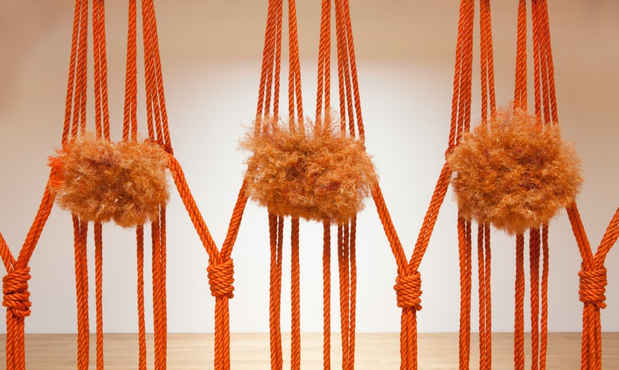Françoise Grossen “Selects”
Museum of Arts & Design

This event has ended.
The Museum of Arts and Design (MAD) presents Françoise Grossen Selects, an exhibition showcasing pioneer fiber artist Françoise Grossen’s selections from MAD’s permanent collection alongside some of her most seminal work, which radically altered the field and possibilities for fiber art and sculpture, and continues to resonate with a new generation of artists.
In the 1960s, Grossen rejected the rectilinear loom that constrained contemporary weaving for an intuitive approach to fiber that resulted in the creation of large-scale, suspended rope forms constructed of knots, loops, braids, and twists. At the time, fiber was still associated with utility or ornament rather than fine art, and Grossen’s freehand, three-dimensional handling of the medium was considered a revolutionary gesture that upset the traditional hierarchy subordinating craft to art. A number of other artists in the 1960s and ‘70s, including Eva Hesse, Sheila Hicks, and Magdalena Abakanowicz, also began working with fiber in innovative ways, and they shared Grossen’s interest in the process of making and the desire for unmediated contact with everyday materials such as rope, string, cord, and twine.
“Françoise Grossen boldly reimagined the potential of fiber as a medium of sculpture at a time when it was considered to be strictly utilitarian, part of the world of textile and interior design rather than fine art,” said Elissa Auther, MAD’s Windgate Research and Collections Curator. “Her work helped pave the way for the art world we know today, in which artists openly use fiber and textiles without worrying about the art/craft divide that once limited the potential of this medium.”
Françoise Grossen Selects is part of MAD’s POV series, which invites guests’ perspectives on the Museum’s permanent collection through the lens of their own practices. For the exhibition, Grossen mined MAD’s collection and brought her own rope sculptures together with a selection of work from the Museum’s unusual collection of baskets, as well as other work in fiber, wood, and metal. Privileging elemental methods of construction as a language of abstraction, Grossen’s selections highlight an approach to contemporary sculpture that focuses on the artist’s direct transformation of material and links it to a wider discussion about ways of making in the culture at large.
Grossen found inspiration in utilitarian structures and objects made of fiber, such as rope suspension bridges, Peruvian khipus, marine ropes for docking and anchoring, and natural forms such as the exoskeletons of insects. Her practice has always involved translating these sources into abstract forms through a cumulative, repetitive approach that she describes as “rope upon rope, braid after braid.” Through this methodical process, her work takes shape, shifts, and mutates into forms that elegantly thematize transformations of the natural and the cultural, from the processing of fiber into rope to its subsequent elevation in her work as a medium of sculpture.
Highlights from the exhibition include:
The early work Signe (1967), also known as Swan, which was included in the Museum of Modern Art’s important 1969 group exhibition Wall Hangings—one of the first shows in the United States to support the work of artists using fiber as a material of sculpture.
Shield (c. 1968), a work constructed through various knotting techniques, including the overhand or half-stitch knot, which enabled Grossen to alternate between elements in active and passive ways to achieve color and scale shifts. Techniques such as the half-stitch are popularly known as macramé, a Spanish word derived from the Arabic migramah, meaning “ornamental fringe.”
A focus on the 1963 exhibition Woven Forms at MAD (then the Museum of Contemporary Crafts), which deeply influenced Grossen when, as a textile student, she saw an adapted version of it at the Museum für Gestaltung in Zurich (then the Kunstgewerbemuseum) in 1964. The exhibition included five artists whose work was representative of the new American fiber art—Alice Adams, Sheila Hicks, Lenore Tawney, Dorian Zachai, and Claire Zeisler—and inspired Grossen through its scale and reinvention of fiber as a medium of sculpture, prompting a move to Los Angeles to complete her MFA in Textiles at the University of California before settling in New York City in 1968.
The stunning site-responsive work Contact III (1977), made out of hand-dyed Manila rope. The work is part of a series of outdoor installations for varied locations, including an alleyway and a pond, among others.
Françoise Grossen Selects is part of MAD Transformations, a series of six exhibitions presented this fall that address artists who have transformed and continue to transform our perceptions of traditional craft mediums. Building upon the exhibition Voulkos: The Breakthrough Years, which celebrates the work of an artist known for drastically changing the way clay is categorized as an art material and discipline, the MAD Transformations exhibitions consider fiber, clay, and jewelry and metals—disciplines (along with glass and wood) that compose the bedrock of the Museum of Arts and Design’s founding mission and collection, and that continue to morph in the hands of contemporary artists today.
Grossen’s exhibition, the first in the POV series to address the full MAD collection, is part of the second season of POV exhibitions, alongside Lauren Kalman’s But if the Crime Is Beautiful… in the Tiffany & Co. Foundation Jewelry Gallery.
Media
Schedule
from October 18, 2016 to March 15, 2017